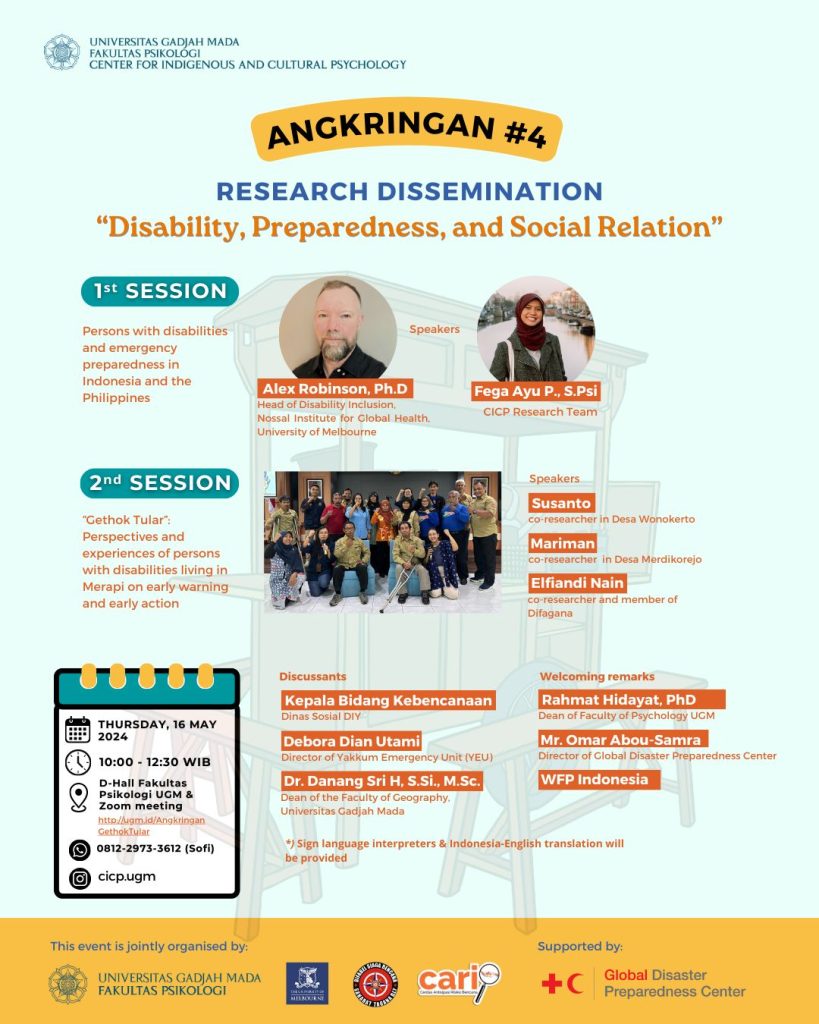
Center for Indigenous and Cultural Psychology (CICP) – Universitas Gadjah Mada along with the Nossal Institute – University of Melbourne, Difabel Siaga Bencana (Difagana), and Global Disaster Preparedness Center (GDPC) collaborate to held the International Research Dissemination: Disability, Preparedness, and Social Relation and “Gethok Tular” Photo Exhibition on May 16, 2024 that is held both offline and online in D-Hall Fakultas Psikologi Universitas Gadjah Mada and via Zoom meeting. This international research dissemination consists of the presentation of findings, programme explanation, dissemination of POP-IDEAS (Perspectives of Persons with Disabilities on Inclusivity and Actionability of Disaster Early Warning System) early findings, experience reflection, responder session, and followed by a question and answer session.
The event started at 10.30 a.m. with the welcoming remarks from Mr. Omar Abou-Samra – Director of Global Disaster Preparedness Center (American Red Cross) and the Representative from World Food Programme Indonesia that is present via Zoom Meeting and also from Ms. Wenty Marina Minza – Vice Dean of Faculty of Psychology UGM.
After the welcoming remarks, there was a presentation of findings about Inclusive Preparedness of Persons with Disabilities in Emergency Preparedness and Response by Mr. Alex Robinson, Ph.D – Head of Disability Inclusion, Nossal Institute for Global Health, University of Melbourne and from Ms. Fega Ayu Pangestika, S.Psi – CICP Research Team. This workshop supports several Sustainable Development Goals (SDGs), a collection of 17 global goals set by the United Nations to address pressing challenges such as poverty, inequality, climate change, environmental degradation, peace, and justice. In particular, the event aligns with Goal 10: Reduced Inequalities, by emphasizing the inclusion of persons with disabilities in disaster preparedness and response, and Goal 11: Sustainable Cities and Communities, by promoting resilience and inclusive disaster risk reduction strategies.
The event was then continued with the programme explanation lead by Ms. Pradytia Putri Pertiwi, Ph.D – Principal Investigator POP-IDEAS which discusses about Perspectives of Persons with Disabilities on Inclusivity and Actionability of Disaster Early Warning System (POP-IDEAS).
Then, it is time for the dissemination of POP-IDEAS early findings by an Enumerator representative of Disaster Preparedness Villages (KSB) and Disaster Preparedness Persons with Disabilities (Difagana): Mr. Susanto (Enumerator at Desa Wonokerto) and Mr. Mariman (Enumerator at Desa Merdikorejo).
Experience reflection by Enumerator comes next after the dissemination. In this session, Mr. Elfiandi Nain – Member of Disaster Preparedness Persons with Disabilities (Difagana) elaborated his personal experience to the participants. Right after that, comes the responder session where the responders; Mr. Sigit Alfianto, S.E., M.E., – Head of Social Protection, Social Affairs, Dinsos DIY, Ms. Debora Dian Utami – Director of Yakkum Emergency Unit (YEU) and Mr. Dr. Danang Sri Hadmoko, S.Si., M.Sc – Dean of the Faculty of Geography Universitas Gadjah Mada responds to the international research findings and elaboration of the programme.
Afterwards, there was a question and answer session. Initially, there was a response from a participant representing BPD DIY (Badan Perwakilan Daerah, Daerah Istimewa Yogyakarta). Following that, there was a question asked by one of the Doctoral candidates regarding participants of the research explained beforehand. Mr. Alex Robinson then answered the question thoroughly.
Following the completion of the entire program, closing statements were given, and a photo session featuring each speaker who took part in the event was arranged. Lunch breaks follow the conclusion of the event. The lunch, which included a variety of Yogyakarta native dishes, was served by the event committee.
Alongside the international research dissemination, on the left side of the D-Hall of Faculty of Psychology, the “Gethok Tular” photo exhibition was held. There are a total of 19 photos which consist of various memorable items (artifacts) and memorable photos of the respondents. There was also a virtual exhibition of the photos that can be accessed.
